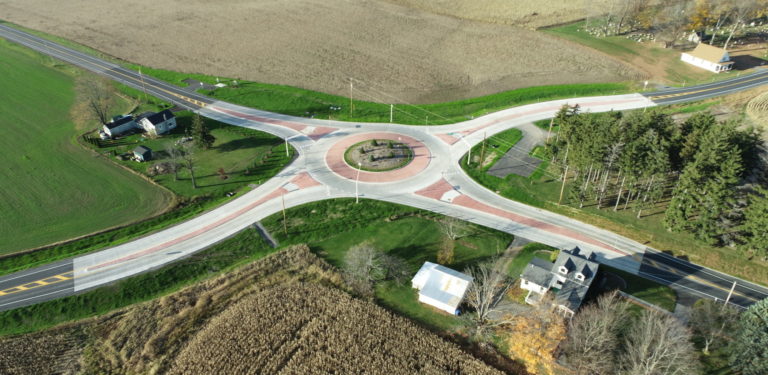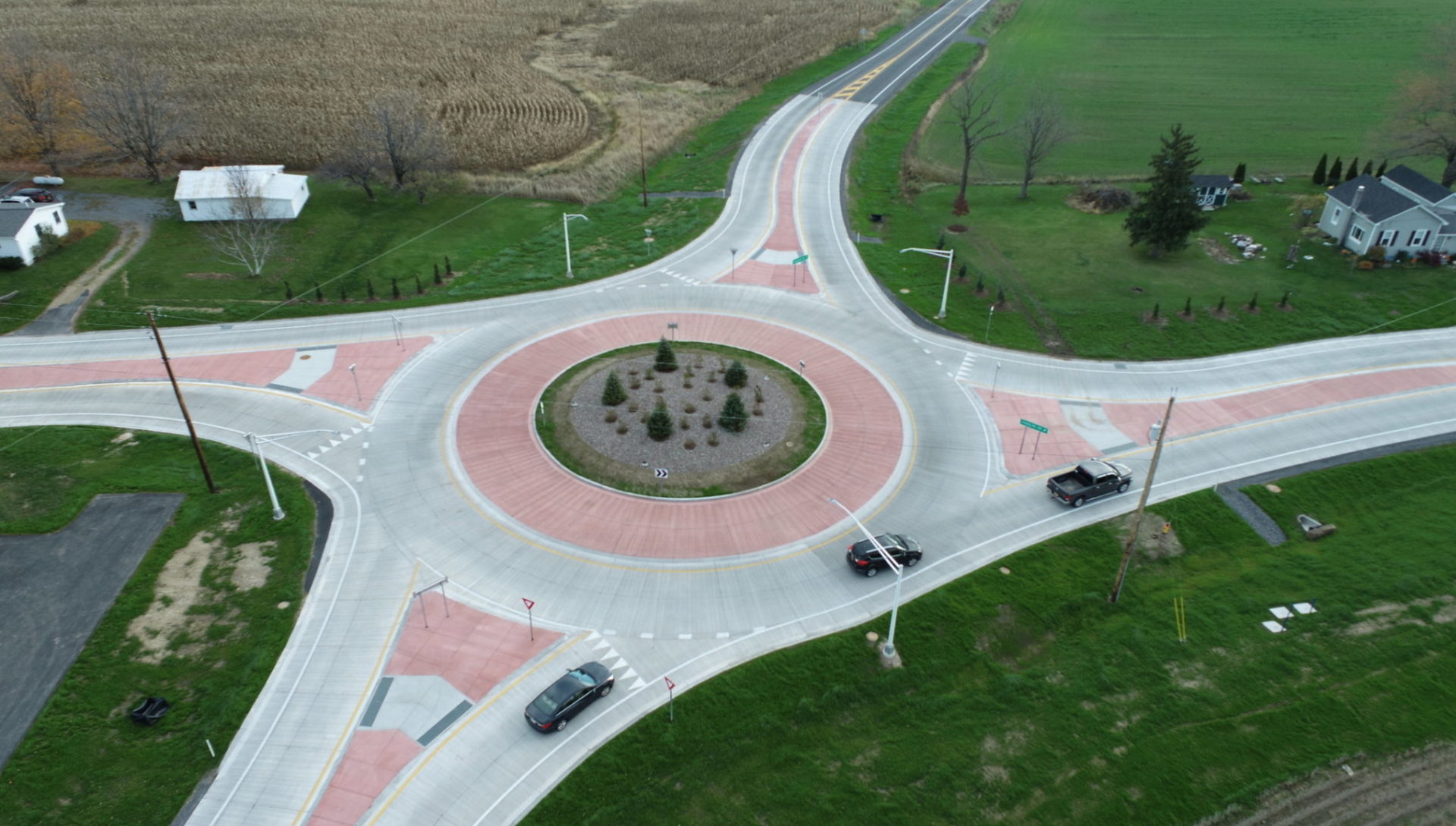The Rationale for Roundabouts

This article was initially published in the May/June 2022 issue of the “Talk of the Towns & Topics”, the bi-monthly publication from the Association of Towns of the State of New York.
How they can play a critical role in rural traffic safety programs
Slow down, wear a seatbelt and don’t drive while impaired or distracted. These seem like common sense steps for drivers, but the latest statistics on traffic fatalities prove that Americans are not heeding this advice.
According to the National Highway Traffic Safety Administration (NHTSA), there were more than 20,000 fatalities due to traffic crashes in the first half of 2021, up over 18% compared to 2020. The main factors being high speed, impaired driving, and failure to wear a seat belt. For rural communities, this is compounded by the fact that traffic fatality rates are nearly 2 times greater than those in urban settings.
The statistics are alarming and have led many communities across New York State to embrace transformative programs that utilize roundabouts as a primary part of their traffic safety strategy.
Roundabouts: Polarizing but Effective
Roundabouts are a polarizing topic for communities and are often the ire of residents and motorists, but they are a practical and effective solution for mitigating traffic incidents and fatal crashes.
In the United States, over half of crashes occur at intersections. Roundabouts are an effective tool for removing conflict points that traditional stop-controlled or signaled intersections retain and have been proven to reduce crashes by over 35% and injury crashes by over 70%.
Implementing a Successful Roundabout Program: Ontario County, NY
Located in the heart of New York’s Finger Lakes region, Ontario County’s roadways are similar to many across the state, with rolling terrain, rural-to-suburban settings, a 55-mph speed limit, and hundreds of 3- and 4-leg stop-controlled intersections. Through a careful review of traffic data, County officials uncovered that 50% of vehicle-related fatalities were occurring on rural roads. Driven by this concerning statistic, officials established a countywide traffic safety program with a focus on intersection improvement, taking a methodical and data-driven approach in line with National Highway Safety standards.
One intersection identified for improvement was the four leg, two-way stop-controlled intersection at County Route 28 and Shortsville Road in the Town of Farmington. The intersection had a crash rate roughly six times higher than the statewide average, and in the years leading up to the redesign was the scene of dozens of serious crashes, including two high-profile fatalities.

Ontario County Public Works contracted with our team of highway engineers, traffic engineers and landscape architects in fall 2018 to lead the transformation of this intersection. Collaborating with stakeholders to develop a modern roundabout, the Team considered a number of key design factors, including:
- Appropriate geometric design to gradually decrease driver approach speeds
- A durable, cost-effective pavement material, utilizing concrete instead of asphalt
- Central island landscaping designed for both aesthetics and functionality
- Lighting levels that illuminate the roundabout for driver safety while reducing glare for immediate neighbors
The intersection reopened in October 2020 and in the 18 months following, traffic incidents have decreased 30%, without any injury-inducing or fatal crashes. The success of this and other redesigns across the county have drawn praise from residents, county and town officials and emergency responders. At the ceremonial ribbon cutting, Shortsville Fire Chief Jason Wagner, who frequently responded to crashes at the intersection, shared his appreciation for local, county and state officials who listened to pleas for a solution and for making the investment so “hopefully I never have to come here again.”
CR 28 and Shortsville Road was the third roundabout redesign we completed for Ontario County. The fifth entered design in the winter of 2021.
The Rationale for Rural Roundabouts
What makes roundabouts a successful design solution for rural intersections? Roundabouts check off four critical boxes, including reducing speed, which is often a top priority for rural communities:
- Roundabouts are a geometric intervention. They are designed so drivers negotiate the intersection at speeds in the range of 15-25 mph, regardless of the speed limits on the approaches.
- Crashes at Ontario County’s rural intersections involve high speeds, which tend to result in severe injuries or fatalities.
- Roundabouts require vehicles to yield on entry and navigate around the raised, circular island; therefore, the possibility of a right-angle crash is substantially reduced. Crashes that occur do so at more acute angles and lower speed.
- In rural environments, it is not uncommon for drivers to miss a stop sign or traffic signal, resulting in a right-angle crash. Signals and all-way stop control intersections rely on driver obedience. Signals and all-way stop control may elevate the potential for high-speed, rear-end collisions.
- Roundabouts eliminate the need to turn left or cross conflicting traffic. Entering vehicles yield to traffic already in the circle and proceed when there is a safe gap. Gaps are easier to judge at lower speeds and in one direction only.
- It can be difficult for a driver turning left or crossing the major road to properly assess the speed of approaching vehicles, resulting in mistakes and potentially severe crashes.
- Roundabouts with four approaches result in 8 possible points of vehicular conflict.
- Traditional four-way intersections have 32 possible points of vehicular conflict.

Core Tenants of Program Success
The success of Ontario County’s roundabout program has been due in large part to the collaboration among local and county stakeholders and their methodical, data-driven approach. Communities embarking on their own program should consider the following:
- Be programmatic in your approach
- Establish a focus, identifying and ranking intersections utilizing data
- Identify your network and establish a reference population
- Select performance measures
- Quantify results
- Establish a plan, identifying both low- and high-cost countermeasures
- Identify funding at local, state, and federal levels
- Develop a plan for public communication and buy-in; be prepared for roundabout misconceptions
- Choose partners with the right expertise in traffic planning and intersection design and whose approach aligns with your community values
Implementing the right traffic safety plan can have a significant impact on reducing injury-causing and fatal crashes. While roundabouts can draw frustration from drivers, in the end they save lives.

